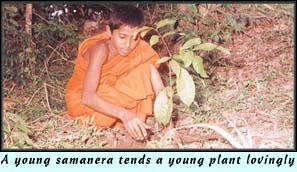 |
 28th February 1999 |
Front Page| |
They spread the message of natureA project involving the temple and the community has been launched to protect forests and nurture medicinal plants By Hiranthi FernandoSet amidst the hills of Walapane, the Watarakgoda Temple goes back a long way. Also known as Pussadeva Rajamaha Viharaya, it is believed that Pussadeva, one of King Dutugemunu's warriors attained enlightenment at this temple.
The project designed to uplift neglected forests with the help of the community and other temples was initiated by a non-governmental organization, the Neo Synthesis Research Centre (NSRC) and sponsored by the Community Environmental Initiatives Facility of the Ministry of Environment and Forestry. The project includes training priests in environmental communication, rehabilitation of neglected forests and cultivation of medicinal plants. Priority has been given to improving the temple forest at Watarakgoda Rajamaha Viharaya. A training centre on environmental issues will be set up there. Initially, 50 Buddhist priests and 60 farmers will be trained to develop analog forestry in their home gardens and temples. Project Coordinator of NSRC, Ajantha Palihawardena explained that analog forestry means multi-layered mixed forest home gardens which are analogous to natural forests. The natural forest is simulated using utility plants such as timber, fruit trees, medicinal plants and spices. "We started the project because there are refugeal forest patches around the temple which are decreasing in area and in terms of bio-diversity," Mr. Palihawardena said. He also traced a close connection between Buddhism and flora and fauna. "Almost all the important events in the life of the Buddha took place under trees. Most of the temples and monasteries where the Buddha lived and preached the dhamma were situated close to forests. "Buddhist literature mentions that while journeying to spread the faith, the Buddha sometimes spent the night in forest caves. In the Vanaropana Sutta of Samyutta Nikaya, the Buddha preached that those who plant trees and shrubs would gather merit. He also recommended the foot of a tree as the best dwelling place for monks," he said. In keeping with the teachings of the Buddha, early Buddhist monks took an interest in protecting the environment. From descriptions of forest temples (aranyas) in Buddhist literature, it can be seen that monks had an influence on forest conservation.They also had knowledge and experience in medicinal plants and the practice of herbal medicine. Speaking of the origins of the Temple Forest Project, Mr. Palihawardena said the lands at Walapane were degraded and largely unused after tobacco cultivation was moved to the dry zone. In 1991, NSRC started a project with farmers for alternative home garden systems. It was then that analog forestry was introduced. "After three years, we had a significant improvement in the soil which was enriched with compost made from tree loppings. Spices, herbs, utility crops and timber trees were cultivated. "During an international workshop on analog forestry, held in Sri Lanka, a field trip was conducted through the forest patch to inspect farmers' lands. Coming up through the temple forest, a bio- diversity specialist suggested that we should start a project with the temple," Mr. Palihawardena said. The director of NSRC, Dr. Ranil Senanayake had discussions with the Chief Priest of the temple. A project proposal was thereafter developed to protect and enhance the bio-diversity around the temple and start up a medicinal garden and environmental training sessions for the priests in the surrounding temples at Walapane. At the Watarakgoda temple in Walapane, a nursery was set up with a wide variety of plants, introduced by the NSRC. The nursery included lime, mahogany, pepper, kohomba, divul, mango, pihimbiya, na, avocado, passion fruit, and spices. It also had an uncommon fruit tree which they referred to as ice cream beans.
He said it was decided to start a medicinal garden because traditionally,priests had an insight into such plants and Ayurveda. However, many priests today, are unable to identify the various plants. Even if they identify them, they cannot obtain the quantities required for preparing the decoctions. A series of environmental training sessions by experts in the field have been prepared for the bhikkus. They will also be trained to prepare simple remedies for common ailments which they could prescribe to the villagers, Mr. Palihawardena said. The priests who follow the sessions can go out to their own temples and put into practice what they have learned. The network of Buddhist temples throughout the country, and a combined temple and community effort, could successfully contribute to the conservation of forests and increase the production of traditional medicinal plants. |
||
 |
More Plus * That magnificent class of '49
Front Page| News/Comment| Editorial/Opinion| Business| Sports | Mirror Magazine |
|
 |
Please send your comments and suggestions on this web site to |
|
 According
to the chief incumbent of the temple, Rev. Dodamkumbura Dheerananda Thero,
a small chaitya, a Bo tree, some ancient stones and stone receptacles found
in the upper part of the temple date back to that period. The temple is
surrounded by ten acres of land, of which seven acres are forest. The forest,
rich in bio-diversity, is inhabited by about five species of birds endemic
to Sri Lanka and 30 other species. Because of this feature, the temple
has been selected as a centre for a temple forest project.
According
to the chief incumbent of the temple, Rev. Dodamkumbura Dheerananda Thero,
a small chaitya, a Bo tree, some ancient stones and stone receptacles found
in the upper part of the temple date back to that period. The temple is
surrounded by ten acres of land, of which seven acres are forest. The forest,
rich in bio-diversity, is inhabited by about five species of birds endemic
to Sri Lanka and 30 other species. Because of this feature, the temple
has been selected as a centre for a temple forest project. The
nursery plants are cared for by the priests and samaneras in the temple.
The Chief Priest said that nursery plants had been given to 30 farmers
so far.
The
nursery plants are cared for by the priests and samaneras in the temple.
The Chief Priest said that nursery plants had been given to 30 farmers
so far.